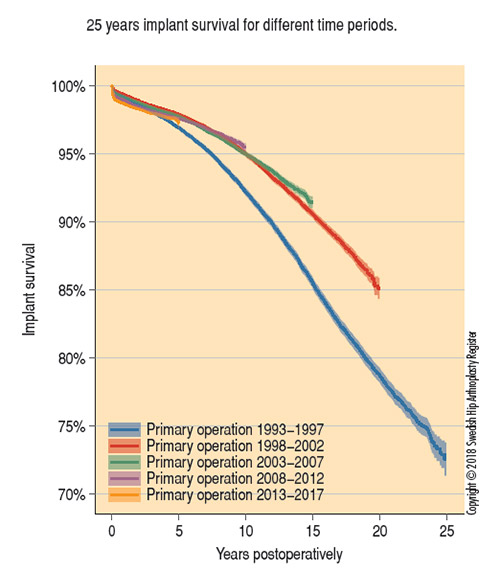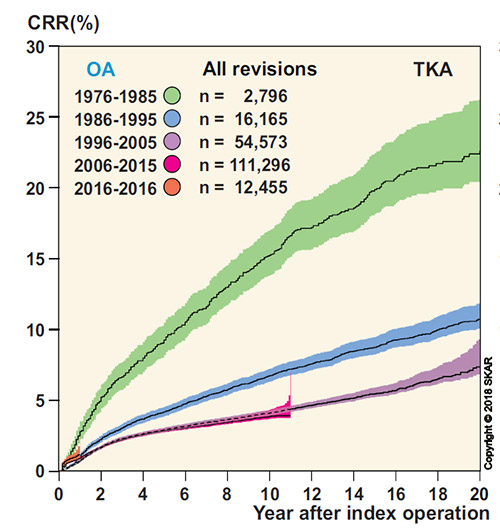
While joint replacements are extremely effective in restoring function to joints damaged by injury or disease, they do not last forever. They are mechanical devices that are exposed to the high stresses of daily activity.
The typical lifespan for joint implants has traditionally been thought to be 10 to 15 years, but surprisingly, this is not true. In reviewing the most recent information on this topic, I was astounded to find out how long these implants last.
What the Numbers Say about Joint Replacement
Hip Implant Survival Rate Study
The best sources for this information are national hip and knee registries. The Swedish Hip Register is one of the oldest such databases and its annual reports are available for download in English. The best thing about these joint registries is that they include almost every total hip replacement done in the entire country. They can pick up on early outliers for implants, facilities, and even surgeons who are not living up to expectations. In the 2017 report, the investigators beautifully map out the rates of revision for 25-year periods starting from 1993 to now. As you can see in the graph below, the more recent implants do not have as long of a follow-up. What is encouraging is that the rates of revision appear to be decreasing with almost every 5-year period studied. Another positive piece of information is that even among very old implants — those implanted between 1993 and 1997, there was still a survival rate of around 73 percent at 25 years. This means that if you were to extrapolate this line at 30 years, at least 60 percent of the implants would still be in the patients. That is remarkable.
 Figure 1. Source: Swedish Hip Arthroplasty Register
Figure 1. Source: Swedish Hip Arthroplasty Register
Knee Implant Survival Rate Study
For knees, we find similar good news. In the 2018 Annual Report of the Swedish Knee Register, we can see almost the same findings graphed out in Figure 2 as for the hips in Figure 1. The only difference is that they turned the graph upside down. Instead of reporting survival, the information reports the rate of revision, the opposite of survival of the implant. In the graph below, we see that the newest knee replacements are surviving at a high rate — around 92 percent at 20 years. That extrapolates to over 80 percent at 30 or 35 years staying in the patients. The other interesting finding is that once again things are improving. The green line for cases performed between 1976 and 1985 did worse than the blue line for cases performed between 1986 and 1995, which in turn did worse than the purple line for cases performed between 1996 and 2005.
 Figure 2
Figure 2
Joint Replacement Study Takeaways
The take-home point is that both hip and knee replacements fail at very low rates and, more importantly, the rate of their failure is decreasing with new technology such as better materials, surgical education, and improved precision such as robotics for implant placement.
In spite of this good news, we still see occasional hip and knee replacements that are failing for a variety of reasons.
If you would like to discuss joint replacements, please contact our office to schedule an appointment.




 How Long Do Joint Replacements Last?
How Long Do Joint Replacements Last? 








